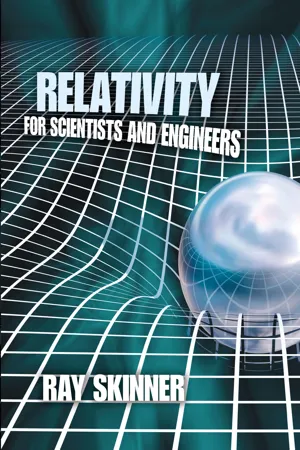![]()
Special Relativity Theory: Kinematics1
Our notions of space and time are derived from experiences with relative positions, clocks, motions, etc. These notions are refined as our range of experience increases, as can be confirmed by anyone who has watched an infant reach for a distant object or waited for a young child to return “in just a moment,” or by one who has become more and more familiar with motions of objects and the laws to which these motions are subject. An improvement in understanding of our everyday notions of space and time is not enough, though; like all our other ideas, these notions and the basis for them must be scrutinized continuously for hidden fallacies as the range of our experiences is expanded. If necessary, these notions must be modified with the insight provided by new experiences. We cannot maintain ideas that are contrary to experience or, in other words, that disagree with experiment. This book focuses on the modification of our usual views of space and time and the consequent changes in the laws of motion resulting from new information provided by experiments performed in the last half of the nineteenth century.
The basis for our familiar notions of space and time is provided by our knowledge of the common motions of everyday experience, such as the motions of a ball or a car. These motions are correctly described by a set of laws introduced by the great English physicist and mathematician Sir Isaac Newton (1642–1727). His laws of motion are also valid to a high degree of accuracy when applied to the motions of the planets in the Solar System, extending some 1013 m across space and involving periods of 1010 sec. On the other hand, Newton’s laws were used* by the father of nuclear physics, Sir Ernest Rutherford (1871–1937), in his analysis of the experiments that led to the discovery of the atomic nucleus, an object measuring about 10–14 m across, which experienced collisions for about 10–20 sec in those experiments. The range of validity of Newton’s laws is limited, however; the special theory of relativity is required for the description of some phenomena that are not correctly described by Newton’s laws.
The special theory of relativity is based on concepts of space and time that differ from those applicable in newtonian mechanics (although the concepts of relativity theory are compatible with the newtonian concepts in their common range of validity). There is a natural division of subject matter in the special theory of relativity: (1) kinematics, which is the study of the concepts of space and time and the means of describing the motions of objects; (2) dynamics, which is the study of the regularities in these motions or the rules that govern them. The kinematics of special relativity form the subject matter of this chapter; the dynamics of special relativity are discussed in Chapter 2.
Newtonian mechanics represents a precise statement of our intuitive ideas about the common motions of everyday experience. Therefore, it is worthwhile at this point to review the kinematics of newtonian mechanics as a preliminary step in our study of the modifications in newtonian kinematics required by the special theory of relativity.
Newton maintained that time was absolute: that is, every observer can determine time intervals relative to a time standar...
